Related Research Articles
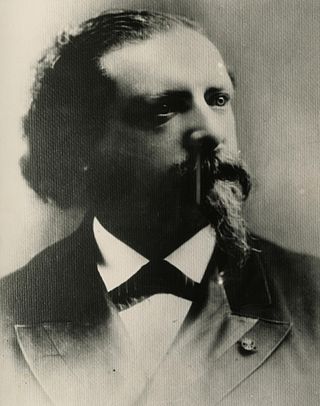
Edward Selig Salomon was a German-American politician and military official. Born into a Jewish family in the Duchy of Schleswig in modern-day Germany, he immigrated to the United States as a young adult and served as a lieutenant colonel for the Union during the American Civil War. After nomination for appointment to the grade of brevet brigadier general of volunteers to rank from March 13, 1865, by President Andrew Johnson on January 13, 1866, the United States Senate confirmed the appointment on March 12, 1866. Salomon later became governor of Washington Territory and a California legislator.

Andrew Jackson Smith was a United States Army general during the American Civil War, rising to the command of a corps. He was most noted for his victory over Confederate General Stephen D. Lee at the Battle of Tupelo, Mississippi, on July 14, 1864.

John Charles Black was a Democratic U.S. Congressman from Illinois. He received the Medal of Honor for his actions as a Union Army lieutenant colonel and regimental commander at the Battle of Prairie Grove during the American Civil War.

Theophilus Francis Rodenbough was born in Easton, Pennsylvania and was a Union Army officer during the American Civil War. He received America's highest military decoration the Medal of Honor for his actions at the Battle of Trevilian Station. After his retirement from the U.S. Army in 1870, he wrote several books about military history.

Amasa Cobb was an American politician and judge. He was the 6th and 9th Chief Justice of the Nebraska Supreme Court and the 5th Mayor of Lincoln, Nebraska. Earlier in his life, he was a United States Congressman from Wisconsin for 8 years and served as the 13th Speaker of the Wisconsin State Assembly. He also served as a Union Army officer during the American Civil War.

Charles Lane Fitzhugh was a Union Army colonel during the American Civil War, who was later appointed a brevet brigadier general of volunteers for gallantry, energy and ability and a brevet brigadier general in the regular U.S. Army for gallant and meritorious services in the field during the war.

Innis Newton Palmer was a career officer in the United States Army, serving in the Mexican–American War, the Civil War, and on the Western frontier.
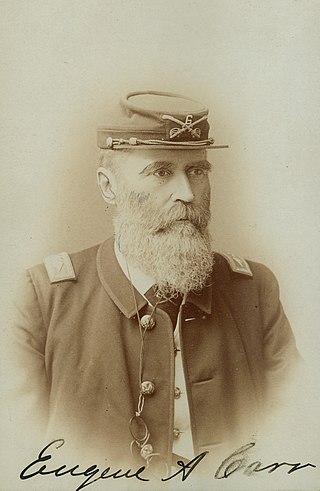
Eugene Asa Niel Carr was a soldier in the United States Army and a general in the Union Army during the American Civil War. He was awarded the Medal of Honor for his actions at the Battle of Pea Ridge.

John Irvin Gregg was a career U.S. Army officer. He fought in the Mexican–American War and during the American Civil War as a colonel and near the end of the war as a brevet general in the Union army. In 1866, he was nominated and confirmed as a brevet major general of volunteers and a brevet brigadier general in the Regular Army, both to rank from March 13, 1865.
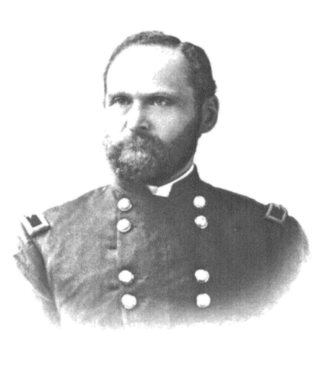
Aaron Simon Daggett was a career United States Army officer. He was the last surviving brevet Union general of the American Civil War, and the last surviving general of any grade from the war, when he died exactly one month shy of his 101st birthday in 1938. Daggett was nominated for appointment to the grade of brevet brigadier general, to rank from March 13, 1865, by President Andrew Johnson on February 21, 1866 and was confirmed by the United States Senate on April 10, 1866. During the war, Daggett fought at West Point, Gaines' Mill, Golding's Farm, White Oak Swamp, Second Bull Run, South Mountain, Antietam, Rappahannock Station, Fredericksburg, Battle of Gettysburg, Battle of Mine Run, Battle of the Wilderness and Battle of Cold Harbor. Daggett was a brigadier general of volunteers in the Spanish–American War. He was appointed to the brigadier general grade to rank from September 1, 1898 and was mustered out of the volunteers on November 30, 1898. He was promoted to brigadier general in the Regular Army ten days before his retirement from the army on March 2, 1901.

Eli Long was a general in the Union Army during the American Civil War.

Gilbert Marquis LaFayette Johnson was an officer in the Union Army from Indiana during the American Civil War, reaching the rank of colonel. In 1866, he was nominated and confirmed for appointment to the grade of brevet brigadier general.
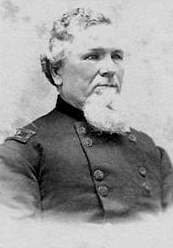
Thomas Duncan was a career officer in the U.S. Army, serving as a lieutenant colonel during the American Civil War. In 1867, he was nominated and confirmed for appointment as a brevet brigadier general in the regular army, to rank from March 13, 1865, for his service in the Civil War.

Thomas Worcester Hyde was an American Union Army colonel, a state senator from Maine, and the founder of the Bath Iron Works, one of the major shipyards in the United States. He wrote two books about his experiences during the American Civil War and at the Battle of Gettysburg.
Samuel Perkins Spear was an American soldier who saw combat in the Seminole Wars, the Mexican–American War, and the Civil War.

John Elisha Phelps was a Union Army officer during the American Civil War.

Caspar Crowninshield was a volunteer officer in the Union Army during the American Civil War.
Sylvester Gardner Hill (1820-1864) was a colonel in the Union Army during the American Civil War. He served as a brigade commander during the Red River Campaign and Battle of Nashville where he was killed in action. He received a posthumous appointment as a brevet brigadier general.
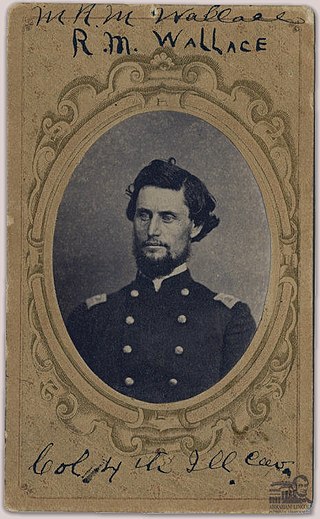
Martin Reuben Merritt Wallace was a Union Army officer from October 12, 1861, to November 3, 1864, during the American Civil War. He was colonel of the 4th Regiment Illinois Volunteer Cavalry when he was mustered out of the volunteers on November 3, 1864. In recognition of his service, in May 1866, he was nominated for appointment and confirmed to the grade of brevet brigadier general of volunteers, to rank from March 13, 1865.
Adolph Engelmann was a farmer, lawyer, postmaster, Mexican–American War veteran, and Union Army colonel during the American Civil War. On May 18, 1866, the United States Senate confirmed his appointment as brevet brigadier general of volunteers.
References
- 1 2 3 4 5 Eicher, John H.; Eicher, David J. (2001). Civil War High Commands. Stanford, CA: Stanford University Press. p. 164. ISBN 978-0-8047-3641-1.
- ↑ "3rd Illinois Cavalry Consolidated in the American Civil War" . Retrieved April 30, 2012.
- ↑ "The Robert Carnahan Letters" . Retrieved April 30, 2012.
- ↑ "Organization of the U.S. Forces, commanded by Maj. Gen. George H. Thomas, at the battle of Nashville, Tenn., December 15-16, 1864" . Retrieved April 30, 2012.
- ↑ Eicher, 2001, p. 742.